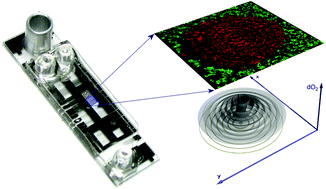A microsystem for sensing and patterning oxidative microgradients during cell culture†
Abstract
We present the design, modeling, fabrication and testing of a microsystem for the electrolytic patterning and sensing of oxidative microgradients within 1 × 1 mm2 area during cell culture. The system employs an array of microfabricated electrodes (3–40 µm in width) embedded in gas-permeable microchannels to generate precise doses of dissolved oxygen (ranging from 10 fmol O2 mm−2 s−1 to 100 nmol O2 mm−2 s−1) via electrolysis. The microgradients generated by different microelectrodes in the array can be superimposed to pattern multi-dimensional oxygen profiles not possible with other methods. We demonstrate the patterning, sensing and quantification of dissolved oxygen microgradients in the 0 to 40% dO2 range using this microsystem. Reactive oxygen species generation and dosing is also quantified. Lastly, we demonstrate how the microtechnology enables new types of experiments in three different cell culture models: localized hyperoxia-induced apoptosis in C2C12 myoblasts, dynamic aerotaxis assays of Bacillus subtilis, and studies of calcium release in an ischemia/re-oxygenation myoblast model.


 Please wait while we load your content...
Please wait while we load your content...